new posts in all blogs
Viewing: Blog Posts Tagged with: Childrens stories, Most Recent at Top [Help]
Results 26 - 49 of 49
How to use this Page
You are viewing the most recent posts tagged with the words: Childrens stories in the JacketFlap blog reader. What is a tag? Think of a tag as a keyword or category label. Tags can both help you find posts on JacketFlap.com as well as provide an easy way for you to "remember" and classify posts for later recall. Try adding a tag yourself by clicking "Add a tag" below a post's header. Scroll down through the list of Recent Posts in the left column and click on a post title that sounds interesting. You can view all posts from a specific blog by clicking the Blog name in the right column, or you can click a 'More Posts from this Blog' link in any individual post.
By:
jrpoulter,
on 1/30/2011
Blog:
Jrpoulter's Weblog
(
Login to Add to MyJacketFlap)
JacketFlap tags:
verse,
performance,
imagery,
story books,
SCWBI,
Australian Poetry,
humorous verse,
nonsense verse,
children's verse,
narrative verse,
humorous poetry,
iphone app,
creative writing workshops,
creative arts,
sites,
ipad,
review,
children,
children's books,
books,
science fiction,
illustration,
Links,
Reading,
Reviews,
Poetry,
humour,
Literacy,
Fiction,
picture books,
young adult fiction,
teen fiction,
Writing,
inspiration,
Education,
e-books,
fantasy,
journals,
magazines,
children's literature,
Teacher Resource,
Reviewing,
haiku,
publishers,
children's stories,
Add a tag
This series of links were included as part of an article I wrote for WQ Magazine,”Markets – from woe to go and getting a foot in overseas! ” [March issue 2011] . Sadly, the actual links had to be removed due to space restrictions so I have placed most of them here.
This list of resources, sources and publishing opportunities on the internet and elsewhere is far from exhaustive. Please do contact me if you have or know of a resource that can be included!
Review Blogs and sites
Book Review blogs
Debra Sloan – The Picnic Basket http://www.thepicnic-basket.com/
Carol Denbow – A Book Inside http://abookinside.blogspot.com/ Magdalena Ball – Compulsive Reader http://www.compulsivereader.com/html/
Susan Whitfield http://susanwhitfield.blogspot.com/
Jo Linsdell – Writers and Authors http://writersandauthors.blogspot.com
Betty Dravis & co-bloggers - Dames of Dialogue http://damesofdialogue.wordpress.com/
New Zealand Writer – http://new-zealand-writer.blogspot.com
Sarah Chavez-Detka http://minorreads.blogspot.com/
Kerry Neary http://kerryneary.blogspot.com/
Free Press Relese DIY site - http://www.prlog.org/submit-free-press-release.html
Sites
All genres:
Goodreads – http://www.goodreads.com/
Children’s Literature:
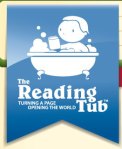
- The Reading Tub
Terry Doherty Reading Tub http://www.thereadingtub.com/
Reading Tub Blog http://readingtub.wordpress.com/
Magazines that publish short stories and poetry
[I have submitted a list of online journals most on Facebook, some with links - http://www.facebook.com/note.php?note_id=10150093435850908 and growing.] New additions
Leaf Garden Press http://leafgardenpress.blogspot.com/
http://leafgardenpress.blogspot.com/2009/01/submissions-open.html
Dash Literary Journal
Rose and Thorn http://www.roseandthornjournal.com/Home_Page.html
Cross genre:
Good Reading – http://www.goodr
By:
jrpoulter,
on 10/9/2010
Blog:
Jrpoulter's Weblog
(
Login to Add to MyJacketFlap)
JacketFlap tags:
family,
Uncategorized,
Fiction,
picture books,
Sydney,
children's literature,
culture,
family life,
collage,
Reviewing,
sleep,
children's stories,
architecture,
Mirror,
Morocco,
Walker Books,
imagery,
story books,
similarities,
creative arts,
differences,
Jeannie Baker,
family bonds,
review,
children,
children's books,
books,
illustration,
Reading,
Reviews,
Add a tag

"Mirror" by Jeannie Baker
In her new book, “Mirror”, Jeannie celebrates the differences that makes up the diversity of world cultures and the elements that unite us, the bonds of family and the mundanities of every day life.
Even the presentation, as two books united within one cover, highlights ’same and different’, but highlights it in a way that draws us closer to both families, the traditional Moroccan family and the modern Australian family.
Turning pages of each book simultaneously, reveals parallel aspects of the daily lives of these very different families. We see them with the intimacy and immediacy of a fly on the wall. They are at work, at meals, settling for the night, shopping and sharing. The colours are luminous and the details absorptive. Words are superfluous!
I have always been a fan of Jeannie Baker’s beautiful, evocative, detailed collages. This latest book is a treasure!
“Mirror” by Jeannie Baker, Walker Books, ISBN 978-1-4063-0914-0.








By:
jrpoulter,
on 10/9/2010
Blog:
Jrpoulter's Weblog
(
Login to Add to MyJacketFlap)
JacketFlap tags:
review,
children's books,
books,
illustration,
Reading,
Fiction,
picture books,
children's literature,
children's stories,
Lane Smith,
Walker Books,
story books,
"It's a Book!",
new technology,
Add a tag
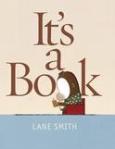
"It's a Book!" by Lane Smith
“Its a Book!” – whilst I am definitely in favour of innovation and new technology, there is nothing like a book! This little gem beautifully and humorously puts books and new tech in perspective! Highly recommended! 
http://www.youtube.com/watch?v=WhUNyzYzBX0
Monkey is absorbed, reading a book. Jackass is busy, playing on his laptop. Jackass gets curious. What is it about this very static, boring looking assemblage of cardboard and paper that has Monkey’s attention so completely? Jackass does what all curious kids do, asks and asks and asks and asks. But, instead of deterring Jackass, Monkey’s repetitive response only spurs him on till, in desperation, Monkey lets Jackass look see for himself.
What is the result? Computer geek Jackass gets hooked on a book and Monkey heads off to the library!
By highlighting what a book is not, Lane Smith cleverly shows exactly the joy, fascination and involvement to be had by turning the pages of a good book. The illustrations humorously depict the characters of Monkey, Jackass and Mouse and further definition is given by the clever use of a different font for each character.
Not a word is wasted in this celebration of what a book is and why we love them!
“It’s a Book!” by Lane Smith, is a Walker Book, ISBN 978-1-921720-14-7.








By:
jrpoulter,
on 6/19/2010
Blog:
Jrpoulter's Weblog
(
Login to Add to MyJacketFlap)
JacketFlap tags:
children,
SCBWI,
children's books,
illustration,
Reading,
Uncategorized,
Fiction,
picture books,
young adult fiction,
Writing,
inspiration,
e-books,
fantasy,
children's literature,
Teacher Resource,
parenting,
children's stories,
kindle,
Penguin,
e-book,
imagery,
story books,
humorous verse,
children's verse,
narrative verse,
humorous poetry,
iphone app,
Library resource,
Home schooling resource,
creative arts,
istorytime,
ipad,
picpocket books,
Ripple Reader,
rodesoft.com,
Elizabeth O. Dulumba,
Add a tag
Hi All
Thought I’d share some notes on e-publishing, especially with all the excitement generated by ipad. I have two picture books coming out myself on iphone and am looking forward to having picture books on ipad!
Iphone
Pros
Most of the iphone publishers pay better [some much better] royalties than book publishers.
Though the RRP cost of books is low, volume of sales is high compared to hard copy books.
Folk buying an e-book for iphone often buy the hardcopy too if the child likes the book.
If you are publishing with an iphone company who works with the big publishers or with big children’s media companies, then it potentially brings your work to the attention of some important networks/people. It puts you book into good company!
Cons
Starts with costing you the author.
There is a setup fee or the set up cost is taken out of your royalties.
You have to make your own audio and ensure it is of ‘professional’ quality or pay to have the iphone publisher produce it for you. American iphone book producers like to use American accents [sorry Aussies].
If they format the text into the images for you that is a cost as well.
You have to submit the completed book upfront [not such a hassle for the author/illustrator] as a pdf. For author working with illustrator it means either you pay the illustrator upfront or they work with you with royalties in mind. If it is accepted you may find you have to then submit each frame [individual jpeg image] resized to iphone format . This can mean force sizing, which can distort the image slightly. If you do not do this yourself, there is a cost for them to do it.
Like all publishers, they are selective.
I have books soon to come out with PicPocket Books and istorytime. [See my website for updates www.jenniferrpoulter.weebly.com - more excitement!]
e-book
kindle
Pro
Good format for b&w and has growing audience.
Con
No colour.
e-book
ipad
Pro
Is all the buzz – is touted as new direction in children’s publishing [most recently at CAL seminar in Brisbane recently]. Not seen as replacing hard copy but as important new outlet.
Penguin are already there, are going for interactive stories on ipad. Exciting! [see UTube and www.engadget.com/.../penguins-ipad-formatted-books-shown-off-making- waves/ ] All the same pluses for iphone also apply here and more.
Con
Same companies doing iphone are now doing ipad as well so the cost structure may still apply – may change too as ipad is much more flexible than iphone and is beautifully suited to picbooks. Because of this, there may not [note may not] be the same need for audio.
Ripple Reader
Pro
If your book is already in hardcopy, it is ‘free’ [yep that’s right] to load your book onto Ripple Reader and free to join the company. Ripple Reader pays royalties! It is an exciting innovation that makes your published book accessible much, much more widely.
Con
Your book must exist in a published version first, so that the editing process it has gone through ensures production quality.
Recommended Reading
Latest SCBWI Newsletter [March/April 2010] page 22 – article by Elizabeth O. Dulemba titled, “My 1st iPhone Picture Book App”. Elizabeth was published with a company called Rhodesoft.com [“Reading Rhino”]. I don’t know as much about them, but they do also require a set up fee.
LINKS
www.jenniferrpoulter
I recently finished a fantasy story originally geared toward middle grade. Realizing it wasn't long enough (not enough words) for a middle grade story, I changed it to a chapter book. Good idea, right?
Yes it is, but if you do something like this, you need to remember to check the age appropriateness of the words you originally used. You might ask why this necessary...well, it's the difference between an editor giving your story a second glance, or not.
It's so important that some publishers ask what grade level your book is geared toward. You had better make sure the vocabulary of your story and the intended audience are a match.
What exactly do I mean? Let's use an example:
The boy performed amazing magic. Was it an illusion or real magic?
If you were writing this for a 6th grader, the word illusion would be fine, but say you are writing for a 3rd or 4th grader...then you'll need to change that word.
According to a book that provides words for children's writers, illusion is in the 6th grader's vocabulary. You would need to change it to a word such as trick or fake to make it age appropriate for a 3rd grader.
The use of words goes far beyond that of choosing age correct words, they can be used to say the same thing using different words. As I'm writing this, I have to keep in mind that I submitted an article to an ezine somewhat similar to this topic. I must change words so the SEO does not pick up this post and link it to the article submitted. Words are so amazing!
Next post will be about three great resources, including the name of the book I mention above, for finding words suitable for particular ages.
Karen
http://dkvwriting4u.com
Stop by DKV Writing 4 U and pick up a GIFT just for visiting:
Classic Christmas Tales (a 235 page e-book with 18 classic stories)
It's on the left top sidebar!
Check out the blog for additional writing information.
I've been writing stories and poems for as long as I can remember. I have a four-drawer chest full of them, there are more stacked in the shelves of a wardrobe once intended to store skivvies, pullovers and underwear; my writing desk hasn’t seen the light of day in three years.
Along the way I’ve had a few nibbles from publishers and magazine editors (but somehow though several have acknowledged the stories make enjoyable reading - and they wished me luck, it seems the particular story was not what the publisher was looking for at this time or it happened they just accepted something similar only yesterday). I have several stories printed in anthologies; an article or two in professional journals, a self-published a children’s picture book - and this last week my story in verse: Red Riding Hood Rap has actually made it into the summer 2009 edition of Alphabet Soup. But none of this reduces my ‘personal’ slush pile.
In a year or ten I’m going to fall off the perch - and all those words that flowed year after year from my heart and my head will end up in some trash pile …
UNLESS
... .... I act now!
So ...
between cleaning my teeth and preparing to entertain a seniors' group with story, song and riddles a week or two ago I came upon a FREE web programme on the internet http://www.wix.com/ It provides the capacity to upload a story (or anything else for that matter) and allow the reader to turn the pages as in a real book. The programme not only includes clip-art and other quirky elements that can be added to the text, it allows users to upload their own illustrations, photos or tables from their computer. (I even managed to create treble clef melody line for the song I wanted in one of my stories).
0 Comments on CABBAGES AND FINGS - with apologies to Lewis Carroll as of 1/1/1900
Interview with Spain’s leading illustrator, The Golden Age continues!“
![capc2b4n-dominguez Angel Dominguez [for sketch of Captain Cleveland]](http://jrpoulter.files.wordpress.com/2009/03/capc2b4n-dominguez.jpg?w=199&h=300)
Angel Dominguez - for sketch of Captain Cleveland
Jennifer: Fans of Dulac and Rackham do not despair, they have a worthy successor. The art of Angel Dominguez has already been compared master illustrators of the Golden Age of book illustration. He has the vibrant colour and pattern of Dulac and both the delicate and the quirkily grotesque approach to fantasy characterisation for which Rackham was famous. Angel, I believe you formally started your career in illustration in 1971? What influenced you to choose such a career? Are there other artists in your family background?
Angel: “Curiously and curiously” as Alice says… because my master is Arthur Rackham, but you´re right, I also love Edmund Dulac. Many people say I´m more like Dulac. In writing on the topic,“The Master illustrator of the Golden Age of book illustration”, you must write about Rackham and Dulac, both have the same quality and charm.
I had an uncle, who was a very good painter in oils. So if you ask about genetics, I think that maybe there is a link, but to be an artist it is really only necessary to love art and all that’s around us.
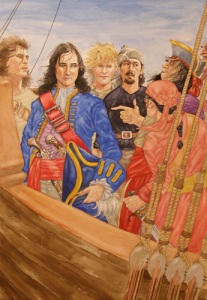
Captain Cleveland
My strongest influence in choosing to illustrate children’s books was Arthur Rackham without a doubt. I remember, as a child, having a book in my hands with a little and awful reproduction of “The Mad Hatter’s Tea Party” from Alice in Wonderland. It was so bad, I was even unable to read the signature of the artist…but, in that moment, I knew I wanted to do that wonderful kind of art. I fell in love with that imaginative place too, the Mad Hatter and the other characters, with that cottage and background… I felt a lot of sensations, good inner reactions to that technique of painting. I WANTED to do the same! And further, visiting London, I saw a lot of books by that artist… and now I have nearly all his books on my shelves. I did Alice´s Adventures in Wonderland with Artisan of New York and I was the happiest man on Earth. I did The Mad Hatter’s Tea Party with special affection, and the original was sold quickly. People even asked me to paint other ‘originals’ of that same scene.
Jennifer: Who were the artists, you feel, had the most influence on your style as a young illustrator and why?
Angel: If we talk about fantasy (also I´m wildlife artist) my strongest influential artists were:
1st CAVE ART:
All the amazing paintings on the walls of the caves, from Altamira, the best, I think, to all others around the world, in the deserts of Africa, America…
2nd ABORIGENS:
I love each nationality of artists in the wild, for all of the continents, but specially the Australian Aborigines, they painted wonderful art on rocks and on bark… I was so inspired, I also did some paintings in this medium.
3rd COMIC:
Alex Niño, Bernie Wrightson, Sergio Toppi, Josep Mª Beá, Carlos Giménez… a lot of the world of comic.
4th BOOK S ILLUSTRATORS:
Arthur Rackham, Edmund Dulac, John Bauer, Beatrix Potter, Kay Nielsen… a lot too.
GENERAL:
Speaking of ART… I must mention too Gustav Klimt, Egon Schiele… and the masters of China and Japan, specially Hokusai, whose books on Manga were one of the most wonderful pieces of art that I ever saw.
Jennifer: What inspires you most in the creation of your art?
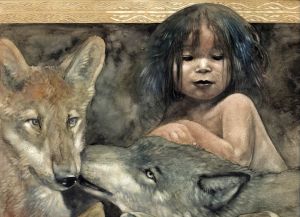
Mowgli and the Wolves
Angel: Animals and plants… Nature, Beauty and Love.
A beautiful lady, a nice orchid, a wonderful gorilla, an elephant… the amazing giraffe, that incredible animal which still is with us on this planet. The blue whale… the little mice, the birds… with colors and forms without end.
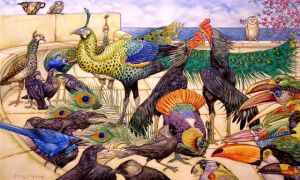
Aesop's Fables - The Vain Jackdaw
To save the wonderful creatures in this amazing world is in the forefront of my interest, so, painting them to show all their beauty and their interaction with their interesting human companions as they appear together in the wild, this is my goal. As Sir David Attenborough said, he likes to show nature’s wonders in order to preserve them; he never liked to do movies with “distressing messages to the innocent bystander who was at home sitting in their chair.” But it´s difficult, you cannot forget, for example, the bushmen of the Kalahari desert, who are disappearing so fast, already it is a challenge to find a family complete - and all due to the diamonds under their feet… and the powerful people don´t know that the true diamonds are these very same tribes folk?
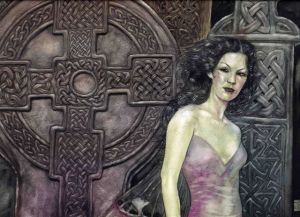
Celtic inspiration - detail
The variation in art inspires me… I see a wonderful book on Celtic art and I WANT to do Celtic art… I see an interesting carved wood or stone… and I would like to do the same. In fact, I saw a picture by Arthur Rackham and that was the start in my career as illustrator, I wanted to do images like that.
Jennifer: Every body is different some can only paint when inspired, some have a daily routine. How do you approach your work?
Angel: Setting down to work is a daily ‘routine’, constantly having in mind the sketch book for each work in which roughs are done when I´m inspired, so, the results come together in the right way. Routine is a word that artists must categorise as ‘forbidden’. In fact, I hate schedules, or… I´m unable to use them, so, let me see… I think that I don´t use schedules nor “daily routine” per se! This, speaking of my work in the fantasy genre only, because I also work on wildlife art, which is the easiest for me, and in this case, routine isn’t a trouble to me. The truly ‘work’ of art is the fantasy world. The inevitable is to work hard.
Jennifer: Does your native region of Basque Country, its geography, history and legends play a part in who you are as an artist and has it influenced your style? I know you travel in Europe and the United Kingdom and Celtic influences are obvious in your love of delicate, interwoven patterns and symbols. How have they come to be part of what is your signature style?

Basque influence - Mari, Queen of the Basque
Angel: As a Basque, I think that the woods of this country inspired me as much as the wild life of England near where Rackham lived at Arundel, inspired him; he loved trees, me too. The mountains and nature of Basque Country are a magnificent source of inspiration to me, and have been from my childhood. Also the Basque Myths are interesting to me, and our books are feature plenty of faery characters of all kinds, … perfect for my fantasy.
Of course, every time I do a trip, I take a lot of sketches and photographs, I want to carry with me every wonder that I find. I like the Pubs of London a lot, I have photographs of almost every one of them, and I wanted to do a book only on pubs… well, I did some pictures and two of them were printed in my book Diary of a Victorian Mouse. One of these Pubs, The Porcupine, did a set of postcards of my drawing in this book, and they were sold in that Pub. To drink a pint of good beer looking at these postcards was a nice moment.
Also, I knew in England the wonderful Celtic art in the Book of Kells and Lindisfarne Gospels, what a collection of striking calligraphy and patterns and borders… I love all of these wonderful books.
Jennifer: You have an obvious love for storytelling, your pictures talk to the viewer, do you deliberately put layers of story into your works or is this a right brain thing that happens as part of the creative process?

Arabian Nights - Mediterranean, Moroccan and Basque influences
Angel: Both, I think. We the illustrators, well, the artists in general, we put in our creations our acquired culture throughout our lives, spontaneously, and those details which aren´t spontaneous, with hard work. So, the viewer can admire our culture and enjoy our hard work.
Jennifer: You have a very keen eye for detail, especially in your drawings of wildlife. But you animals are more than just good anatomical representations, they leap from the page! Do you carry a sketchbook with you, a camera or do you rely on memory or zoological sources?
Angel: Again, both, every tool helps me. My sketchbook, my camera, my memory… AND… my loved books, movies, stamps and cards. Memory is the less important. Having talked about memory’s role in our work with my artists friends, all agree in this, and more… I know a gag:
-“I heard that memory is the intelligence of fools”… said a man to a friend…
-“Yes, and so it is because I forget everything”.
Always I carry a little sketchbook with me, and when a good idea comes, I draw it… and after, I put it in larger sketchbooks, which often have better drawings than in the same published books!
Jennifer: Can you share with me and the readers some of your earliest experiences with art?
Angel: The very first, as a baby… was an “O” filled with a pencil… I needed to fill that blank room. Well, this book, of my father, is still with me, and I have no better drawings with me from my childhood, which was awful. Due to the work of my father, we were doing trips up and down to many places, and all my drawings from school and that which I did at home were lost… a pity… and they were a lot indeed. This happened to Hokusai too, but worse; all the first pictures, from a wonderful stage in his life, disappeared in a fire that burned his house… and, further, he never was able in to do them again, although he did try to recreate them.
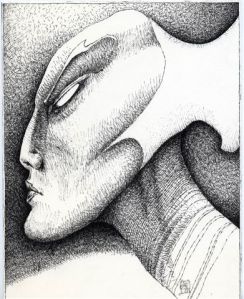
Fedra
Further, as a youngster, I did comics, and I won two first prizes, with my creation Fedra, a woman of the future as heroine… and I´m thinking of following up with further work on her some day, not too much later on. I have some good ideas for her, but in the form of a book not as a comic.
Jennifer: You have done some outstanding work illustrating new editions of such all time classics as “Alice in Wonderland” and “Wind in the Willows”. This must have presented some unique challenges.
How do you approach a project such as “Alice in Wonderland” which has already had many well know illustrators put their stamp on it?
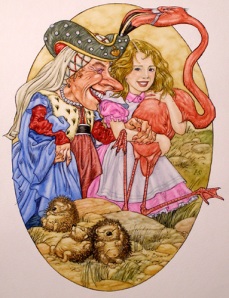
Alice and the Duchess from Alice in Wonderland
Angel: Easy for me, I love Alice in Wonderland very much… I approached this story WITH EMOTION, which is THE GOAL OF ART, as another artist said, Goyo Dominguez –not a relative. I love this special world created by Carroll so much, that not only do I love the story but each of the characters, of course, the writer, the illustrated editions… England, in a word. I wanted to go to England to feel the origin of the book, the mood… to visit a lot of bookshops, to buy a lot of old books, not only of Alice, but of the Victorian times. Each part of my book is full of plenty of messages.
And, if you look closely at many Victorian times (Carroll’s time), The Great Exhibition was held in the Crystal Palace… The objects on display came from all parts of the world, including India and the countries with recent white settlements, such as Australia and New Zealand, that constituted the new empire.
So, I took advantage of this event which, at that time, had the effect of familiarizing English society with foreign wildlife, to paint the wonderful animals that you have there in Australia into the illustrations.
If you ask to me about the very first approach to this book I must say that I had two pencil drawings from many years ago… and my wife said me:
“Angel, you must finish that pair of drawings and send them to a publisher”. I did it… and the answer, from Artisan (WORKMAN, of New York):
-“Please do you be so kind to paint another six watercolors”… and I did it… and the contract arrived fast.
And about other ‘meaning’… I approached the story having in mind a lot of things, not only the many illustrators, and Disney´s wonderful characters, but thinking to do a VERY good work… and I think that I did it, because the edition of 25.000 items were sold.
Also I´m thinking of doing a book on this book… with a lot of interesting things from Carroll´s world, the jokes, characters and details that I included.
[Rabbit sends in a littel Bill - Alice in Wonderland]

Some details are hidden… as my own wife said, I work a lot on each plate… so much of that spontaneously included ‘meaning’ is lost.
[There goes Bill - Alice and Wonderland]
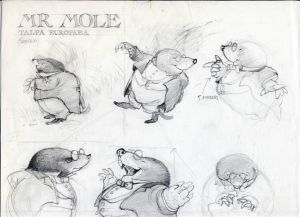
Mr. Mole - Wind in the Willows
As yet I haven’t illustrated The Wind in the Willows… I only drew a pair of watercolors… and already they have been sold in England. They have yet to see the light in the form of a book… who knows, may be that will be my last book to illustrate, as Rackham himself did.
Jennifer: What stories and books hold fondest and earliest memories for you? Do they play, do you think, a part in your choice of projects?
Angel: Of course, Alice is one of them. I read it many years ago, many times… and, as I think that half my soul is English, I understood it very well, and I enjoyed it… specially in thinking to illustrate it.
Other good books to me are:
THE SECRET GARDEN by Frances Hodgson Burnett
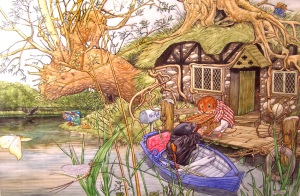
Ratty and Mole - The Wind in the Willows
THE WIND IN THE WILLOWS by Kenneth Grahame
PETER PAN by James Barry
THE UGLY DUCK, the best tale I think.
CINDERELLA, another strong story.
UNDINE by Baron de la Motte-Fouqué, another of the greatest.
PINOCHIO by Collodi.
GRIMM´S Fairy Tales
![marquis-of-carabas-puss-in-boots3 Marquis of Carabas [Puss in Boots]](http://jrpoulter.files.wordpress.com/2009/03/marquis-of-carabas-puss-in-boots3.jpg?w=217&h=300)
Marquis of Carabas - Puss in Boots
A lot of books and stories… difficult to remember all of them and not wanting to bore people. And of course these stories are part of my life and my love for my profession.
Jennifer: Where are you hoping to take your art to next? What projects are coming up?
Angel: As I learned from my English friends, it is often preferable not talk about them. This is done with a number of intentions… it prevents the risk of ideas being copied. To chose a book to do already is an idea, specially when a classic. And to the readers, if the project doesn’t go ahead, that is disappointing news… and if appears as a surprise, it´s good news, something interesting.
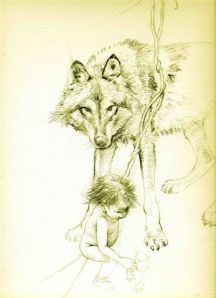
Layering and Symbolism - Mowgli and his wolf Mother
I can say that I´m currently working on The Jungle Book by Kipling. I must get that finished this very month. Also I´m proud to said that I´m working on books with friends from JacketFlap. I´ll find free time to paint good watercolors for good stories that suit my style a lot. I must say that, at JacketFlap, I have found very good friends, not only Tracy and Eric, but others as wonderful models for my pictures. Artists are always searching for good models, and here I found a lot, who were happy to let me draw them. I have a lot of friends as models, not only in Spain, but in the States and in England. It´s funny when I gift some book to them… some have been very touched. One lovely lady cried with joyous surprise when she saw herself portrayed in a color plate in a book on pirates.
Jennifer: Have you ever thought of designing film sets or dabbling in animation? Tim Burton has brought some darker legends to life in an animated film noire for older children. Have you ever thought of doing something like this?
Angel: By the way, there´re a possibility that I can work with Tim in the movie of Alice which he is working on right now!. I´ll keep you posted if this goes ahead.
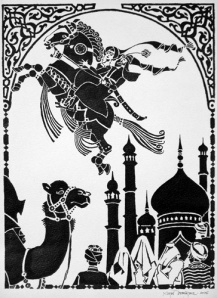
The Arabian Nights - Silhouette
I have some part of my brain that thinks along the same lines as Burton, but not specially in relation to the dark side of those stories, but the fantasy element. For example, The Legend of Sleepy Hollow also is one of my favourite books, also illustrated by Rackham. Not all are dark, if you see Corpse Bride, you’ll agree that it’s a tender love story. And the main character of The Nightmare Before Christmas is tender too, with the sad or smiling face, long legs, walking and dancing and singing all the time.
Yes, always I loved animated films, specially Disney´s, and movies are part of our lives. And it´s a matter of luck to find someone to work with. For example, also I have a friend who can introduce me to James Cameron´s movies, and the last movie, AVATAR was suitable for me to paint the creatures, but I arrived late to this project and the Blue Lady, the main character I think, is very different than the one I could create… mine would be without tail. I knew the thriller version of this movie due to my American friend, and I envy that wonderful life in other world. Si-Fi is one of my preferences in books and movies. I love the books by Ray Bradbury, I have all of them. And I think that Arthur C. Clarke is good indeed, but I prefer the poet Bradbury, I feel his world as if it were mine. I´m pretty sure that Bradbury is the best writer in the world. I would like to illustrate each of his books or to do all of them in movies.
When I was very young I liked animation a lot, to work in this world was a dream, but right now I like more doing good illustrations to books, or backgrounds and creating characters to the movies.
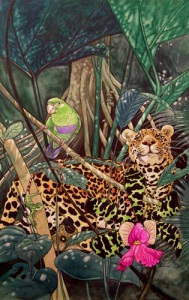
Anaconda- Front Cover art
Jennifer: Lastly, Angel, is there a question you would like to answer, something I have not covered? Now is your chance to cover it!
Angel:
Being a book illustrator, I have been fortunate to find a lot of wonderful friends and have had many unique life experiences. I have fans in England, USA and Australia right now… I traveled to many interesting places, but the most fascinating of them was Jordania, where I met Queen Rania and I collaborated on a book with her! Also I´m working in four projects with friends I have met through Jacketflap.
Also I want to express how grateful I am to the publishers of all the world, without them, we, the illustrators cannot apply our art:
-MICHAEL O´MARA BOOKS and VICTOR GOLLANCZ of London.
-ARTISAN of New York.
-JUVENTUD of Barcelona.
-IBAIZABAL AND ELKAR of Basque Country.
-SHOGAKUKAN of Japan.
Lastly, I wish PEACE in the world… all of us must take advantage of every opportunity to tell how important is to save the world from a sooner end. This interview is such an opportunity.
One of the wisest men in the world, Jose Luis Sampedro, a Spanish writer and a very old and peaceful man, said yesterday on TV in Spain that the end of the world is in the hands of the powerful people but crisis doesn’t damage them, so, they don´t want to look for a solution.
And I add from sayings by the native Americans, the Indians, one of their best sayings, “money can’t be eaten, and that when water is scarce and air becomes unbreathable, there will be no money to fix it.”
TWO EXHIBITIONS OF ORIGINALS by ANGEL DOMINGUEZ
Angel is holding two exhibitions in Britain. The link to the first is below.
At Salisbury Museum, you can see the exhibition of Angel’s originals of Alice in Wonderfland, together with his illustrations for Narnia and Tales by Hans Christian Andersen. The items are for sale.
The Wonder of Illustration
Saturday, 04 April, 2009
Saturday 4 April - Saturday 4 July 2009.
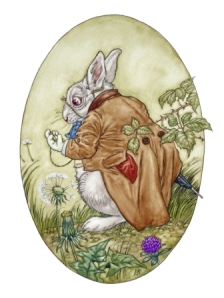
Down the Rabbit Hole - on sale at "The Wonder of Illustration" Exhibition, Salisbury Museum
http://www.salisburymuseum.org.uk/events/index.php?Action=2&thID=232&prev=1
The second exhibition of Angel Dominguez originals is at
Birmingham Autumn Fair.
Items on display are for sale.







Bernhard Oberdieck
The Art of Illustrating for Children and Some Survival Initiatives for Illustrators! - An Interview with Bernhard Oberdieck - storyteller with paint and pen
Jennifer: Bernhard you have already covered in detail the extraordinary processes and techniques you utilise to create your wonderful images. [Readers - I highly recommend a visit to http://www.bernhard-oberdieck.com/en/technik.php to gain an insight into the workings behind Bernhard’s creations.] You have an astounding output – around 200 books by my estimation! What I want to cover in this interview is the background to all this amazing creativity.
You talked about developing ideas in the studio and doing variations of an idea until it is ‘right’ especially in relation to the layout of text. Do you also carry an artist’s notebook with you when you travel in case a solution occurs to you for a particular illustrative problem or an inspiration comes? Could you share one of your more challenging projects with us?
BERNARD: No, I don’t take an artist’s notebook with me if I travel. Previously, as a professional illustrator and as a student, I have drawn and painted a lot from nature and I have visited a lot of museums to study the old masters. Today I draw almost everything freely from my head or I look at photos or old illustrations from old books which I use as stimulus and inspiration. Some I utilise their basic layout in changed form in my illustrations. A good example of this is the circus illustration. Here I took an old photo, I made several years before in the South of France. I deleted some houses in the middle and placed the circus tent in their place. Because I illustrate daily about 8-12 hours, I take no drawing materials in hand in my free time.
Jennifer: Yes I see the very varied sources of inspiration coming through. This particular picture reminds me of some of the works of Japanese hanga woodcuts.

Maustitel - Mouse & Berries - reminiscent of Hanga woodcuts
Do you ever develop pictures purely because you want to as an artist and not for an illustrative project? Are there particular themes you enjoy painting more than others and why?
BERNARD: Yes, I also sometimes paint as purely an ‘artist’. But these pictures are abstract, very different from my illustrations and, up to now, only for myself.( http://www.bernhard-oberdieck.com/art.php) As an illustrator, I always try to interpret the text to so that children will get the most from the book. Maintaining the highest quality in my illustrative work is important to me. I illustrate many themes but I prefer illustrations with animals, I don’t know why.
Jennifer: Some of the stunning wildlife and landscape photographs on you website show you to be a skilled photographic artist [see http://www.bernhard-oberdieck.com/en/galerie2.php] .
Are your photographs a source of inspiration or more a reference tool in the studio, especially during winter months? Or are they another form of your art you exhibit&/ or utilise in cards and calendars?
BERNARD: I illustrate a lot from my imagination and my recollection. Only if I must draw something exactly, do I refer to photos and older illustrations.
Jennifer: You have a very strong sense of place. The atmosphere in your landscapes and streetscapes is humming with story.

Storm by Berhard Oberdieck
What I mean by that is you have captured the feel of the moment, the storm is almost audible rolling across the sky.
You can feel the ripple of the waters.

Ripples, Mouse and Owl by Bernhard Oberdieck
The reader/viewer is able to step into your pictures and observe the story first hand. Have you always had such a strong connection with nature and your surroundings? What are your fondest memories of the outdoors? How has where you live/have lived shaped your art?
BERNARD: Yes, this is exactly right. I have very strong recollections of my childhood. This was lived on the land and amongst the beauties of nature. I grew up in a very small town and also live now in a small village with only 300 inhabitants. This has very much stamped me and my work. And, of course, I was influenced by the books which I read as a child. This is an image of my native landscape, where I was born. ( http://www.bernhard-oberdieck.com/image/Illustration_32.php )
Jennifer: Sense of place also includes interiors. In Germany, you have so much history in your buildings, so much atmosphere built up over centuries that the buildings have character of their own.
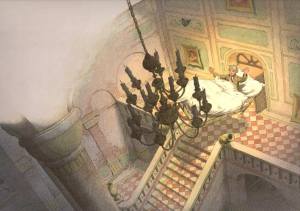
Floating bed and stairs by Bernhard Oberdieck
Would you share with us your source of inspiration and how and why you chose the particular perspectives for such wonderful creations as the following pictures ?
BERNARD: I don’t believe that here, in my Illustrative work, German history plays any special role. I always try, to make my illustrations a little more interesting for the viewer by using special perspectives. Of course I try to lure the children to explore the pictures more closely by adding in a lot of interesting, curious and imaginative little things. It is certainly more interesting for them to discover a treasure trove of unexpected details.
Jennifer: Your love of nature and keen observation come out strongly in the botanical detail of the plants and trees in your pictures. Do you draw plants and animals from life or memory or from field sketches?
BERNARD: Photos, old books, magazines and also the Internet - these are all things I use.
Jennifer: The ability to give distinctive characterisation to animals/toys is another feature of your work.

Bear & pillow by Bernhard Oberdieck
As a guide to up and coming illustrators and art students, can you describe to us how you achieve the strength of feeling, the humour and the drama in animal faces or is it something that comes instinctively?
BERNARD: I think it comes instinctively. In addition, the publishing company and the children expect figures (animals) that they can identify with from fiction and their own memories and experience with their soft animal toys. pets and zoo or farm animals. And, in addition, one must sometimes humanize them.
Jennifer: I love the drama and the humour in some of your eye-catching perspectives. Did pictures such as these come to mind spontaneously or did you work through a number
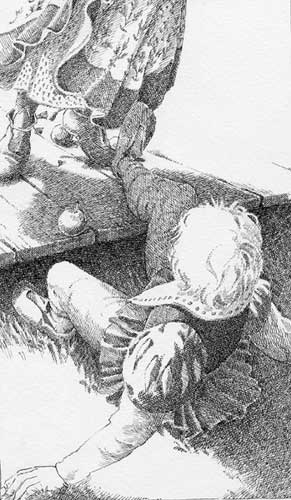
Fall by Bernhard Oberdieck
of experimental stages? Do you consciously look for extraordinary angles?
BERNARD: These pictures come to mind spontaneously. If I begin, I generally already have a picture in my head. Not always, but very often.
Jennifer: Many illustrators end up writing some of their own stories, e.g., Ian Beck and Mick Inkpen. Have you ever written any stories of your own, is that something you hope to do at some future stage? What are your plans for 2009?
BERNARD: No, I don’t write books. I simply have no time for this, because, for example, in 2009 I must illustrate 4 new picture books and certainly also other small works.
Jennifer: Time! Yes, I think you speak for all of us. I know I wish I had 24 more hours in each day! We all look forward to seeing your new projects out on the shelves. To have a peak at Bernhard’s stunning latest project go to : http://kibook.blogspot.com/
Jennifer: Finally, do you have a question that I and other interviewers have failed to ask and which you would love answer? Now is your opportunity!
BERNARD: I would only like to say that, unfortunately, the financial conditions of the professional illustrators is becoming worse and worse. Here in Germany, even more than in England or the USA, this is the sad case. Thank you for this interview.
Jennifer: My pleasure Bernhard and, yes, I hear what you are saying. Out in Australia it is a similar situation. We have a small population and competition is tight and money is tight. Most authors and illustrators out here have to hold down day time jobs as well. I have been thinking about ways in which creators might make some more out of their work. Here is what I have come up with so far…..
Become an Associate -
Most of us have websites and blogs and membership of organisations like SCWBI or State/National Writers’ Centres or Illustrator’s Guilds. But there are opportunities to become an associate of a site like Amazon. Place a link on your site to Amazon. [I can give more instructions re this if you would like.] If anyone buys a book via the link to Amazon on your site, you get a percentage of resulting sales; I believe it is 15%. Now there’s a way to advertise and get more from the sale of your own published works!
Join networking sites -
JacketFlap is just AMAZING - free and THE best networking site around for anyone working in any aspect of children’s literature or just interested in children’s books! There is also Published Authors, free to join and growing daily. It has a branch devoted to networking for the smaller publishers which is also free to join via Published Authors [site moderator is Shelagh Watkins].
Marketing blogs -
Carol Denbow’s blog is well worth a visit - she regularly puts up all sorts of useful tips and tricks - even a ‘How to do it yourself free’ virtual book tour.
Cards, Calendars and MySoti
-

Kuchen - Cake Capers by Bernhard Oberdieck
There is the ability to ‘ merchandise’ art with spin offs as posters, cards and calendars [ as Bernhard already does] and there is MySoti and other sites like it that allow artists to add their original artwork to T-shirts that MySoti then markets for them, paying them a monthly commission on sales.
Poster Poems/Micro Stories
This is an initiative I have developed in liaison with Pierre Lapointe and Marcus Riedner of Sharing Books (http://www.sharing-books.com/).
Many of you very talented illustrators have pictures or sketches which -
· you have done for your own enjoyment or
· you have the beginnings of picture books that did not get to publication for whatever reason, or
· illustrations that were not used in a particular project.
These works can be sold at online art auctions, sales sites. [I have noted that many of your do this.] But this need not be the end of their money spinning days!
Form a liaison with a writer [there are a wide variety on JacketFlap] and develop these unpublished illustrations/pictures into a Poem Poster or Micro Story Poster. The writer takes your work as the stimulus and creates something that works with it - something that can then be formatted and uploaded to Sharing Books as a downloadable poster. Your copyright is protected - it remains with you. One third of the proceeds from the poster are split between you and the writer. Check the site out. Marcus is readily available to answer any technical queries [he and Pierre are on JacketFlap].
The advantages are -
· Extra international exposure
· Some $$$s potential for a work that was not generating any income previously.
· A chance to show off a wider range of your skills [if you have concentrated on more serious topics, a humorous text will show the potential for your work to be used with this type of material.]
· You are also helping an extremely worthy cause - Room to Read (http://www.roomtoread.org/holidays.html) - an international not-for-profit organisation that provides literacy tuition and books to children in third world countries.
I have done this with numbers of illustrators in my Wacky Wordages on my WordPress blog (http://jrpoulter.wordpress.com/) . In liaison with the illustrators, I am now about to turn some of these into posters.
I’ll keep you ‘postered’ as to how it goes!!!!!!!!!
Sponsors
We all know that governments and commercial organisations sponsor arts festivals and writing communities in various ways, but how about sponsoring a specific arts project e.g., a picture book. Many ‘iconic’ artists like Norman Rockwell did commercial projects to bring in regular income. The Jim Carrey classic “The Truman Show” had sponsor’s products prominently displayed in the ‘live’ sets of a life lived in public. It is only one step further to feature a commercial product in a picture book, e.g., a character riding a particular brand of motorbike, or drinking Coca Cola. I know publishers and artists are often wary of commercial control of their product but let’s explore this potential!
Mentors and Patrons
Mentors are a more modern phenomenon whereby established artists/writers take an emerging talent under their wing. This works well. Let’s expand it!
How about revisiting the much older concept of “Patron“, not for ‘the arts’ broad spectrum, but for individual artists. This was the survival mode for many artists and writers of bygone centuries [see pp 156-157 in "Literature, Culture and Society" by Andre Milner]. Some folk are already doing just this. It would be interesting to know how successfully! Let’s explore a revival!
Comments welcome- let’s explore options!






Jennifer: Hi Ian,
Thanks for agreeing to the interview!
I’ve had a ball tracking through the amazing adventures you’ve had with pen and ink! You have a wealth of
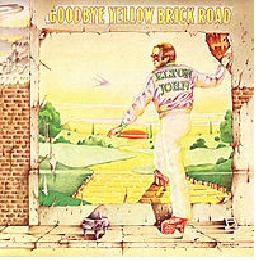
Ian Beck
experience in other arty areas, from designing album covers (including the cover for “Yellow Brick Road”), to advertising, from cards and calendars to murals.
What do you feel this more commercially driven art brought to your work as a children’s book illustrator?
‘Marketing’ is something that seems almost a dirty word to purists but it is an essential part of any saleable product in a competitive marketplace – does the ‘selling’ aspect play any part in your creative process? Should it?
IAN: I began my career as a ‘commercial’ illustrator, making drawings and paintings for anyone who asked, I just wanted to make a living from illustrating. That had been my goal since I was very young and I had noticed ‘spot’ drawings and the like in newspapers and magazines. My ambition had been to do something similar. I spent a very varied and happy twenty years or so in that illustration world. I learned a great deal technically through the trial and error of making drawings for difficult and or demanding clients. I learned patience, and the ability to redraft, remake, remodel, with a smile and good grace. This all helped when I was offered my first children’s book to illustrate (Round and Round the Garden) in 1982. It helped me to be consistent in my coloring, to get the mood of the book as demanded by the editor and designer, a process I was by then very used to. The selling part is obviously important. No publisher wants to make a book that does not sell, nor does any author. I certainly built on my experience in commercial illustration to make my pictures ‘appealing’ if that is the right word. I tried to bring tenderness and charm to my depiction of babies or animal characters. That was how I worked anyway, my commercial work had been influenced by the world of children’s illustration from the word go. I collected illustrated books from my time at Art School, and I still do.
Jennifer: With Heroes like Edward Ardizzone and Harold Jones and a teacher like Raymond Briggs one could say you were always going to end up illustrating children’s books.
What were your favourite books as a child? What images stuck in your mind - were they from books, films or somewhere else? How have these influences shaped your approach to your art?
IAN: I grew up in a house with very few books. Ours was what you would call a ‘blue collar’ family. My father was a milkman, (as was Raymond Briggs’ father) we had a patchy library of mostly old novels, I remember we had volume two of Gone With the Wind, no sign of volume one. The printed images I saw were either in comics, magazines or newspapers. I began my interest by trying to copy those images, often on to the endpapers and flyleaves of the old books that were lying around. Later I joined my local library and began my life long love affair with books and the pictures in them. I started with Hugh Lofting’s Dr Dolittle books. I read all of those in sequence and often reread them too. Later I moved on to Richmal Crompton’s Just William books, and I still read and laugh over those. I think however if there is a single illustration that I remember, that opened my eyes and mind, it was the one by Pauline Baynes, in The Lion the Witch and the Wardrobe, it is of Mr Tumnus out in the snow with his parcels and the street lamp. It still gives me the shivers. I think my own illustration work has been made of so many influences it would be hard for am to untangle them all, but they are all there in some way even if the result is recognizably ‘me’.
Jennifer: The ability to tell a story inside a story as with your book “Five Little Ducks” –How did you set about that now classic ‘Beck’ book?
Was the other story of the fox there from the outset or did it ‘occur to you’ in the way the speaking crow did in Tom Trueheart?
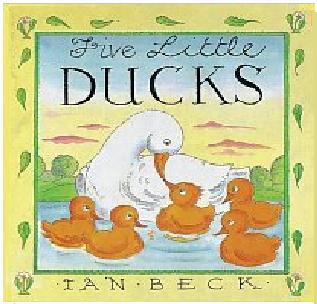
Five Little Ducks by Ian Beck
IAN: As so often happens, Five Little Ducks began as a quite different book. I was discussing with Judith Elliot, then the overall editor at and founder of Orchard Books, the possibility of a book about night time. I had made some roughs, written out some ideas, but it had stalled. Jill Slotover who was an editor there suggested the rhyme of the five little ducks. I saw it complete at once in my mind, the fox, the brave duckling etc etc. I drew some thumbnail sized color visuals in a sketch book, and that was it, go ahead, and I did. It seemed to flow very naturally and was a very positive experience.
Jennifer: This brings me to the ‘right brain’ process present in much of creativity.
In one interview, you spoke of ‘trusting’ an inner nudge that told you to go with the talking crow, even though never envisaged as part of your original idea for Tom’s story.
How does this work in the illustrative process and is it different to that in the writing process?
How do the two creative processes compare?
IAN: In writing a longer story there is naturally a certain amount of planning but as you work on something the imagination creeps up behind you occasionally and goes, ‘boo, weren’t expecting that were you’? This is just what happened with the talking bird, it seems meant and obvious to me now that Jollity the crow should be there, but he was meant at first just to be a target for Tom to throw a snowball at. Once the notion popped into my head that the bird would speak the book opened up for me there and then. My drawings were always planned more rigorously, I was very much in control of them, I can’t imagine the same leap occurring during the making of a drawing.
Jennifer: I’ve checked out http://www.tomtrueheart.com/ and encourage readers to
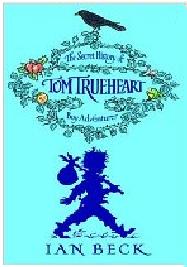
Tom Trueheart: The Secret Adventures of Tom Trueheart by Ian Beck
do ditto! The silhouettes perfectly suit the darker story, but are very different to your style say for example used in “The Teddy Robber” and again from “Puss in Boots”.
How do you decide on your approach to each project?
IAN: The silhouettes were not in the planning of the book at all. I was working on some ideas for the cover of Tom Trueheart with the designer Molly Dallas at Oxford University Press. We had a lot of ideas scattered about on a table, when she remembered that the endpapers I had made for a previous book (The Oxford Nursery Story Book) had used silhouettes. I turned the image of Tom walking with his packstaff into a silhouette and it seemed to click into place at once. It was a short step from that to illustrating the whole book with silhouettes. It was quite a discipline to learn, but a very enjoyable one. So I suppose this approach was unplanned but seemed right. Most of the picture books would be planned with the designer and editor together. They have a valuable input as well after all, quite rightly. Sometimes an editor will say, ‘it would be nice if this book were some thing like this’, and refer to a past book or approach, that certainly happened with The Little Mermaid, I went for the sad and the romantic, the lavish and the wide screen in that book very different to much of my other more graphic output, I imagine for the first and last time.
Jennifer: Any career path is a journey and one might have predicted that having the story teller gift (as demonstrated in “Five Little Ducks”) you would eventually arrive at the point where you wrote your own stories.
Did you always want to do this, or is this a new adventure?
Why now?
IAN: I was encouraged to write my own original story to illustrate by my first editor David Fickling. This became The Teddy Robber, a book still held in affection by readers twenty years later, as I am constantly reminded by teachers and children on
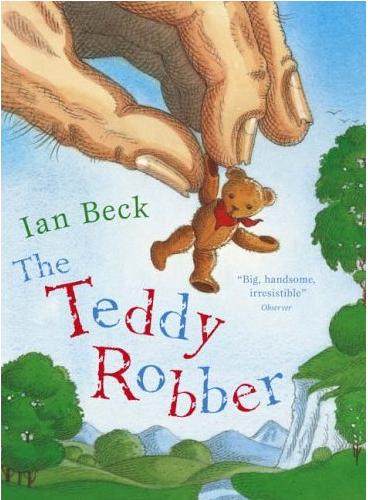
The Teddy Robber by Ian Beck
school visits.
The urge to write narrative though has been with me from the beginning. When I was a young commercial illustrator I went to creative writing classes. It was my intention to write adult fiction. I wrote a couple of short stories, began a novel, but it all ended in a drawer unresolved, unfinished. The urge was still there, the itch, the frustration if you like, but all necessarily suppressed under my busy drawing schedules, the need to earn a living, growing family life etc. Then the seed for Tom Trueheart was planted and grew a little in the potting shed inside my brain. He lay dormant for a while until, sadly, one of my best friends died. This was a big wake up call, as he was younger than me. ‘Come on’, I thought, ’finish that idea, grow that seedling, do what you really want to do, life is too short’. So then Tom actually got finished, with the encouragement of my agent Hilary Delamere. The publisher liked him and so did several other publishers. He is in ten languages now I think, so sometimes trusting your instinct is the way to go.
Jennifer: Tom‘s second book of adventures “Tom Trueheart and the Land of Dark Stories “ is darker by your own admission. The same applied to the progression of J.K.Rowling’s Harry Potter series.
What led to this?
What were the influences at work when you realized a second book needed to be written?
IAN: The second Tom Trueheart adventure came about by chance. I had not intended to write more than one book while I was busy writing the first, it seemed both
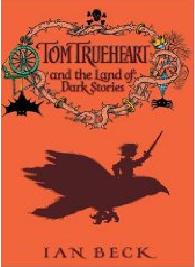
Tom Trueheart and the Land of Dark Stories by Ian Beck
contained, and complete. The first draft ended with Tom confronting the villain Ormestone in a wood and Ormestone turning him into Tom Thumb, ie Tom finally had his own story to complete. My editor Liz Cross read it and said that she didn’t think it was the end of book one, rather she felt it could be the beginning of book two. I was delighted to think that there would be a book two as I had enjoyed writing about Tom so much. Book two needed a new set of stories and characters, there was the unresolved business of Tom’s missing father, maybe he would make an appearance and so on, it all just slotted into place. I used some of those darker fairy story elements, wolves, castles, bats spiders, skeletons, and so on, imagining that the villain would go to where he would be appreciated, and all this with Tom shrunk down to the size of Tom Thumb. It was great fun to do, and I have now nearly finished the third book, provisionally called Tom Trueheart and the Land of Myths and Legends. As you may know Suppertime Entertainment are developing animated films based on the books, so we wait to see what happens next.
Jennifer: How did you feel as an illustrator about someone else doing your illustrative work, as with the book covers for paperback edition in UK [Adam Stower] and the USA edition [Brandon Dorman]?
IAN: It is something of a luxury and a delight to see other artist’s interpretations of my characters and stories. As an illustrator myself you might expect me to be hyper critical, but no, I am very relaxed about it and I very much like what both Brandon Dorman and Adam Stower have done in relation to Tom Trueheart. Just recently, I saw the jacket for Pastworld which is far better than anything I might have done, completely spot on, designed by John Fordham and with an illustration by Paul Young, full of texture and mystery. It was sent to me as a ‘fait accompli’, and I couldn’t be happier with it.
Jennifer: What do we expect to see next?
What about film scripts [ I noted the trailer on your site.]?
What about your own totally Beck picturebooks?
IAN: I have a big novel (in terms of length and ambition) coming out in the summer of 2009. It is called Pastworld. It has taken me four years to develop and complete, Bloomsbury will be publishing. It is a much darker book, aimed at older readers, twelve years and up. A complex book, and hard to sum up in a few words, it is a dark adventure set in what appears to be Victorian London. I suppose you would perhaps categorize it as ‘Steampunk’, there are airships, and murders, and strange passions. It has grown out of my obsession with London, the city I have lived in for forty years, with the science fiction novels of H G Wells, and movies and all sorts of other things muddled together. It may surprise some of my readers, even shock them. It is intended as an older read, it is nothing like Tom Trueheart, and it is not at all cute.
After that I am writing a novel for Oxford provisionally called The Hidden Kingdom, in which the hero is thrust into a sudden drama and the reader discovers the truth as the story develops and at the same time that the hero does. It is set in a mythical place and time and will I hope explore love as one of the subjects.
As to films, I wrote a short story for adults called The Summer House. A young film maker read it and wanted me to adapt it as a screenplay for a short film. I did the adaptation and the film was shot in France two summers ago. Through the magic luck of casting the director Daisy Gili, got Talulah Riley, fresh from the film of Pride and Prejudice as the young female lead, and a boy called Robert Pattinson as the young male lead. Rob of course is playing Edward Cullen in the film of Twilight which just opened ‘big’. So our little 13 minute film now has the added bonus of two rising stars. My son has a film making company and he kindly makes book trailers for me, we are looking forward to making the trailer for Pastworld plus a website where further mysteries can be developed.
As to Picture books, I very much enjoyed illustrating the book Winston The Book Wolf written by Marni
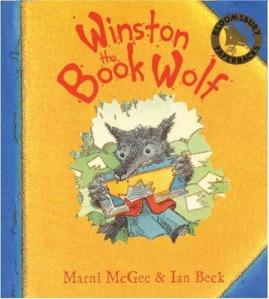
Winston the Book Wolf, illustrated by Ian Beck
McGee, but whether I will ever make another one of my own I don’t know, the longer form seems to have taken over.
Jennifer: You’ve had a lot of interviews that have covered a lot of ground.
Is there a question you wish you had been asked? Okay, now’s your chance! Question and answer – over to you!
Q. What would you have done if you hadn’t made books?
IAN: I would like to have been a ‘café concert’ cabaret entertainer in the mythical Paris of the 1900’s, singing in a tux with a cane, and hanging out with Ravel and Erik Satie and perhaps even having a passionate affair with Colette!
Jennifer: Yep – I can see you doing a Maurice Chevalier complete with top hat!
Maybe that is more than just a dream??????
Now here’s a tantalizing tease - Hidden Kingdom and Pastworld are coming up AND, with one shorter film under his belt already and two animated feature version of the Tom Trueheart books under way, can we expect Ian to be off to Hollywood next with a blockbuster in his sights? Stay tuned!!!!!













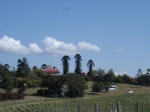
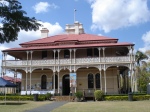

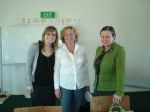
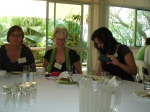
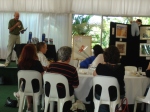
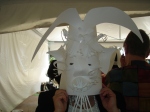
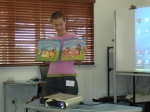
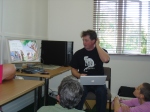
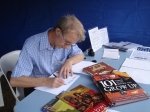
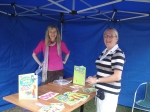
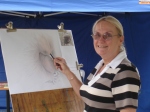
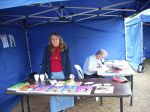

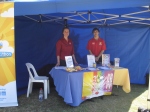

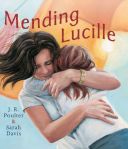


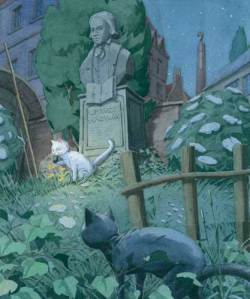
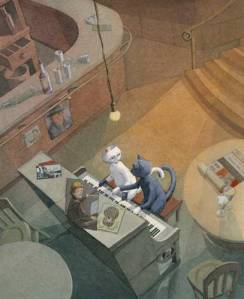
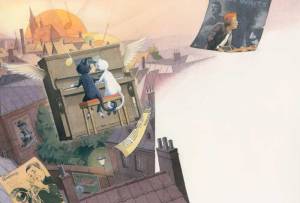
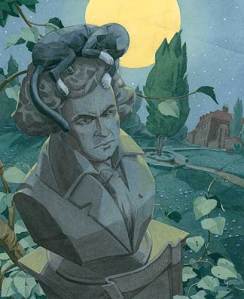


![mending-lucille-cover-highresolution-12 Cover of "Mending Lucille" by J.R.Poulter, illustrated by Sarah Davis [Lothian]](http://jrpoulter.files.wordpress.com/2009/03/mending-lucille-cover-highresolution-12.jpg?w=257&h=300)

![capc2b4n-dominguez Angel Dominguez [for sketch of Captain Cleveland]](http://jrpoulter.files.wordpress.com/2009/03/capc2b4n-dominguez.jpg?w=199&h=300)








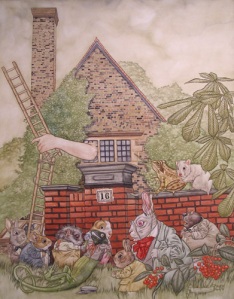



![marquis-of-carabas-puss-in-boots3 Marquis of Carabas [Puss in Boots]](http://jrpoulter.files.wordpress.com/2009/03/marquis-of-carabas-puss-in-boots3.jpg?w=217&h=300)





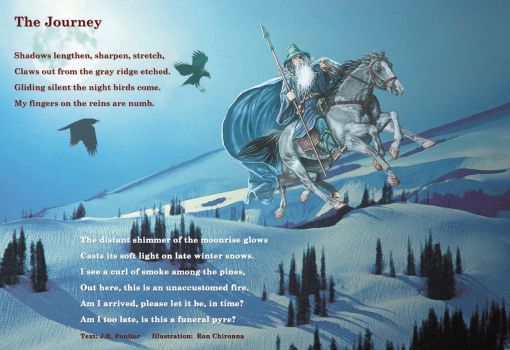



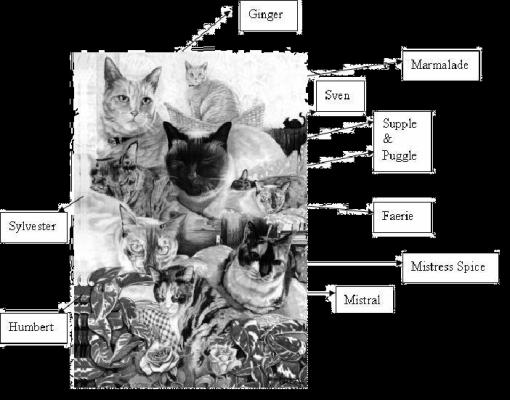

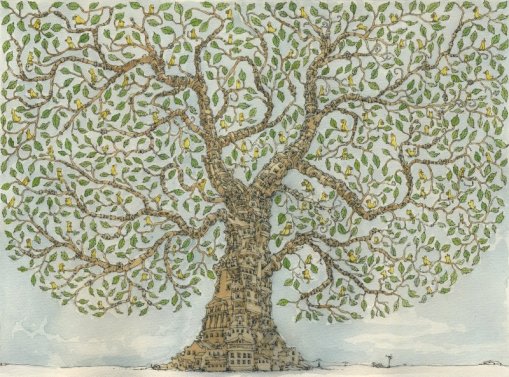

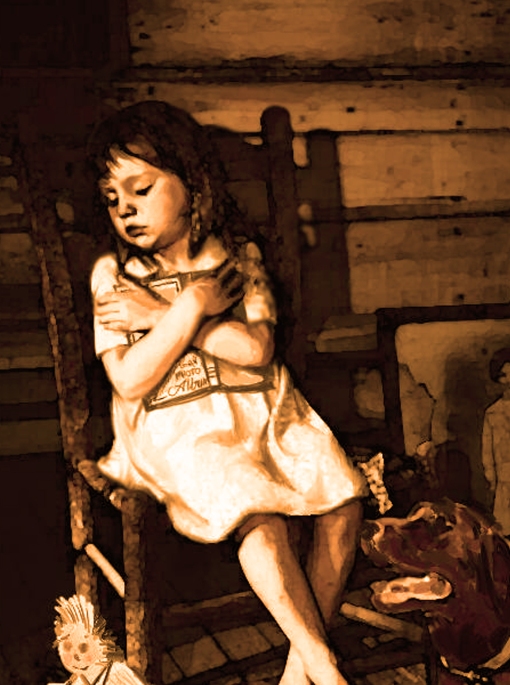

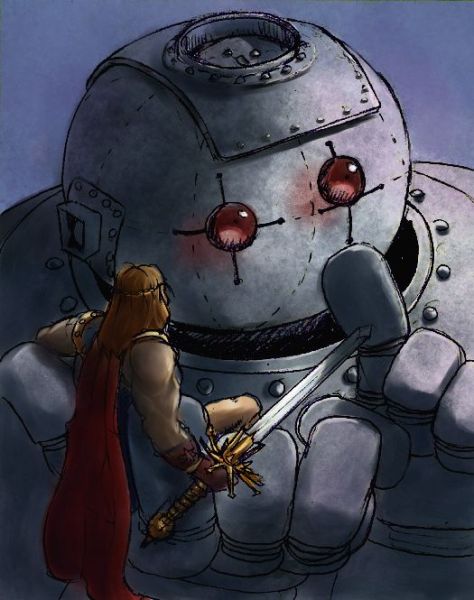



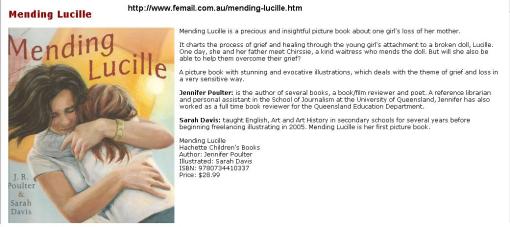


















Great resource, thanks Jennifer! by the way I do book reviews on my blog too: http://www.kangaroobee.wordpress.com
I’ve added you in Catherine!
Thanks Jennifer! I hope I can live up to it
I’m sure you will be insightful and accurately reflect the work to readers!